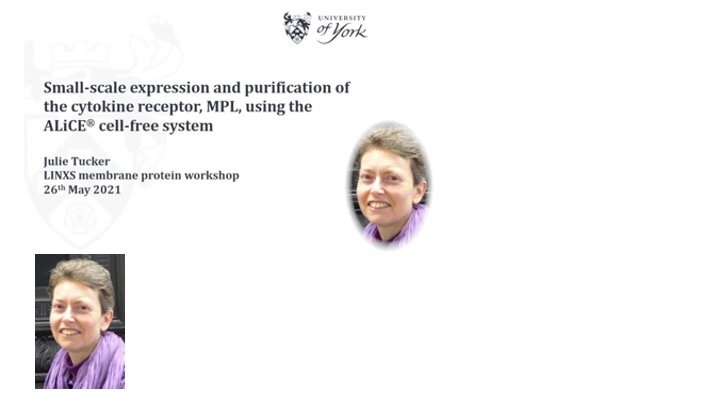VIDEO - Membrane Proteins Workshop - Small-scale expression and purification of the cytokine receptor, MPL, using the ALiCE® cell-free system with Julie Tucker


VIDEO - Membrane Proteins Workshop - Small-scale expression and purification of the cytokine receptor, MPL, using the ALiCE® cell-free system with Julie Tucker
Speaker: Julie Tucker, University of York, UK
This lecture was part of the workshop, Structural Resolution of Membrane Proteins: From Expression to Sample, organised in May 2021 by the LINXS working group Membrane Proteins, which fall under the Integrative Structural Biology theme.
Abstract
MPL (also called TpoR) is the receptor for the haematopoietic cytokine, thrombopoietin (TPO). Together, MPL and TPO control the production of platelets and the maintenance of haematopoietic stem cells. Gain of function mutations in MPL constitute ˜5-10 % of driver mutations in essential
thrombocythemia and primary myelofibrosis, whilst loss of function mutations give rise to thrombocytopenias. MPL comprises an ˜500 aa extracellular domain, a single transmembrane helix, and an ˜120 aa intracellular domain. The extracellular domain contains the thrombopoietin binding site, whilst the intracellular domain provides the binding site for Janus kinase 2, as well as other downstream signalling molecules, including the Signal Transducers and Activators of Transcription (STAT) proteins. Structural information on MPL is lacking, in part due to the challenges of producing recombinant protein. Endogenous expression levels of MPL are very low (< 5000 receptors/cell) and heterologous expression of full-length MPL has not been reported. Here we report small-scale expression and purification of both full-length and ectodomain of MPL using the ALiCE® cell-free expression system (LenioBio GmbH). This plant cell-based system allows for the expression of membrane and secreted proteins within the microsomal compartment, ensuring their correct folding, membrane insertion and glycosylation. Optimisation of expression time, plasmid concentration and downstream processing allowed for production and purification of glycosylated MPL, the functional characterisation of which is ongoing.
